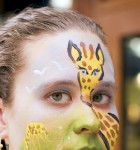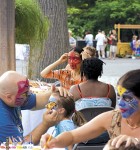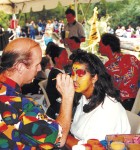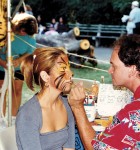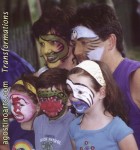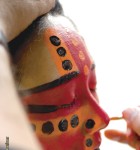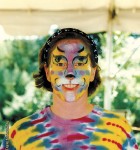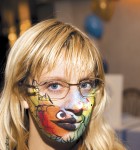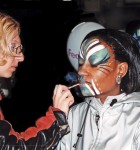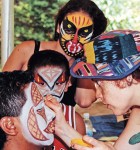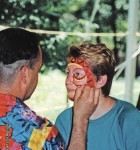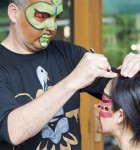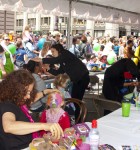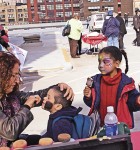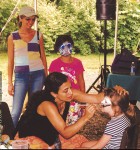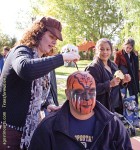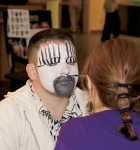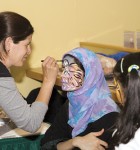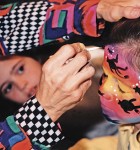Our Transformations technique is to create bold face designs that look exciting both from across the room and up close, based on our studies of theatrical makeup and world mask concepts. We work fast to paint as many people at an event as possible — a face like this zombie would take 3 minutes — so we do take shortcuts and simplify techniques (such as shading), and are less concerned about how a face looks in a foto as we are about it’s effect seen live. At a recent event I took these step-by-step fotos on a guest as I painted him.
 STEP 1: BASE — With a sponge, put a solid base color over the whole face (except the eyelids). Use any medium shade: grey is classic zombie, but can be green, blue or others. (See below for info on the makeup, brushes and sponges we use — and also for a pdf of a green zombie and other variations)
STEP 1: BASE — With a sponge, put a solid base color over the whole face (except the eyelids). Use any medium shade: grey is classic zombie, but can be green, blue or others. (See below for info on the makeup, brushes and sponges we use — and also for a pdf of a green zombie and other variations)
——————————————————————————————————-
 STEP 2: SHADING — Add shading to exaggerate the sunken parts of the face: the eye sockets, the sides of the nose, the lines from the edge of the nose going around the mouth, the hollows on the cheeks and chin. Generally with horror make-up, you want to make the face more dramatic looking by putting shadows into the sunken, fleshy parts of the face and highlights on the bony parts (step 3). I do my shading by painting thin lines with black liquid make-up, then “pulling” those lines with a large soft brush to blend them into the grey base. You can also do your shading with the edge of a sponge — a triangular sponge works well for that.
STEP 2: SHADING — Add shading to exaggerate the sunken parts of the face: the eye sockets, the sides of the nose, the lines from the edge of the nose going around the mouth, the hollows on the cheeks and chin. Generally with horror make-up, you want to make the face more dramatic looking by putting shadows into the sunken, fleshy parts of the face and highlights on the bony parts (step 3). I do my shading by painting thin lines with black liquid make-up, then “pulling” those lines with a large soft brush to blend them into the grey base. You can also do your shading with the edge of a sponge — a triangular sponge works well for that.
——————————————————————————————————-
 STEP 3: HIGHLIGHTS — In this step I use a sponge to lightly put white makeup onto the bridge of the nose, the cheek bones, chin and forehead, to increase the sculpting of the face.
STEP 3: HIGHLIGHTS — In this step I use a sponge to lightly put white makeup onto the bridge of the nose, the cheek bones, chin and forehead, to increase the sculpting of the face.
I also put a bright color (yellow in this case) onto the eyelids to begin to make his zombie eyes.
——————————————————————————————————-
 STEP 4: EYES & MOUTH — I add a red spot for the eyes and black to create the open mouth shape. It’s part of the style that I work in that the mouth is kind of loose and jagged — I like my monster faces to look “ill-formed”, not too precise.
STEP 4: EYES & MOUTH — I add a red spot for the eyes and black to create the open mouth shape. It’s part of the style that I work in that the mouth is kind of loose and jagged — I like my monster faces to look “ill-formed”, not too precise.
——————————————————————————————————-
 STEP 5: FINAL DETAILS and EXPRESSIVE LINES — In this case I gave him small pointy teeth with some red dots for blood. I used what I term “expressive lines” to give his eyes an angrier look — they same kind of line techniques a cartoonist would use to change the expressions of an illustration can create the modern, fast type angry zombie or, with different eye lines, the old-fashioned shambling type zombie (in this case, I modeled off of those furrowed brows they always give the Hulk when he’s angry in comic books).
STEP 5: FINAL DETAILS and EXPRESSIVE LINES — In this case I gave him small pointy teeth with some red dots for blood. I used what I term “expressive lines” to give his eyes an angrier look — they same kind of line techniques a cartoonist would use to change the expressions of an illustration can create the modern, fast type angry zombie or, with different eye lines, the old-fashioned shambling type zombie (in this case, I modeled off of those furrowed brows they always give the Hulk when he’s angry in comic books).
——————————————————————————————————-
 ZOMBIE VARIATIONS — Starting from this basic formula of using shading and highlights to make the face dramatic, using bizarre colors, and adding playful details like a gory mouth and zombie eyes, you can make a whole range of zombies, monsters, and other horror make-ups. The blue shaded zombie here was also painted at the same event. See the 3 previous posts for galleries of Halloween faces and variations.
ZOMBIE VARIATIONS — Starting from this basic formula of using shading and highlights to make the face dramatic, using bizarre colors, and adding playful details like a gory mouth and zombie eyes, you can make a whole range of zombies, monsters, and other horror make-ups. The blue shaded zombie here was also painted at the same event. See the 3 previous posts for galleries of Halloween faces and variations.
Click here for a printable pdf of the step-by-step for a green zombie, and some examples of variations:
Halloween_ZombieHowTo_agostinoarts
——————————————————————————————————-
 MAKE-UP AND TOOLS — There are a lot of good face painting make-ups available today, so please be sure to get a safe, comfortable make-up product for any facepainting. Never use paint on someone’s skin, even paints that say they are non-toxic — always use make-up.
MAKE-UP AND TOOLS — There are a lot of good face painting make-ups available today, so please be sure to get a safe, comfortable make-up product for any facepainting. Never use paint on someone’s skin, even paints that say they are non-toxic — always use make-up.
The brand we prefer is Kryolan’s Aquacolor because of the vivid colors, ease of application and removal, and how comfortable they are to wear. Learn more on our web page http://agostinoarts.com/AboutTheMakeup including where you can get quality make-ups in the NYC area and online. And check out my book: Transformations! The Story Behind the Painted Faces
I apply the Aquacolors with sponges and brushes. I prefer the round craft-type sponges and synthetic sable watercolor brushes.
Learn about all that we do at: agostinoarts.com
Related articles
- Halloween 2013 — Face Painting Gallery #zombieattack
- #ZombieAttack — Halloween Gallery 2: Vampires, Demons, Aliens and Creepy Characters
- #ZombieAttack — Halloween Gallery
- See our video: Getting Into the Halloween Groove
- Japanese Demons and Kabuki Spooky
- Face Painting Gallery — Prospect Park Boo at the Zoo











































